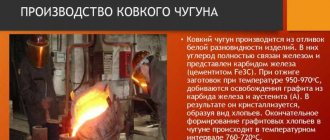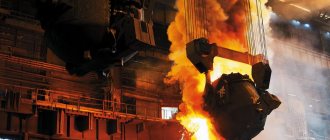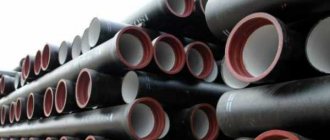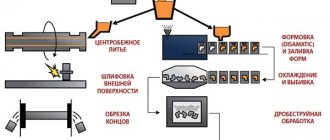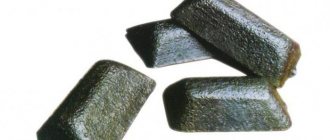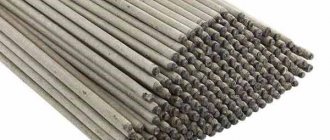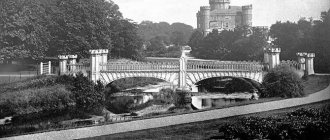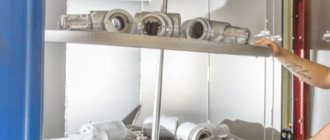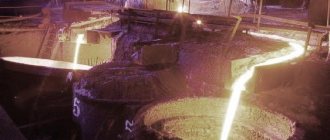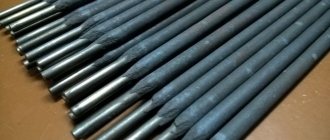Influence of components on the properties of cast irons
Cast iron differs from steel in its higher carbon content and better casting properties. It is not capable of being processed under pressure under normal conditions and is cheaper than steel. Cast iron contains impurities of silicon, manganese, phosphorus and sulfur. Cast irons with special properties contain alloying elements - nickel, chromium, copper, molybdenum, etc. Impurities found in cast iron affect the amount and structure of released graphite.
Rice. 23. Microstructures of cast iron
The mechanical properties of cast iron castings depend on its structure. Cast irons have the following structural components: graphite, ferrite, pearlite, ledeburite and phosphide eutectic. Based on their microstructure, cast irons are divided into white cast iron I (Fig. 23), containing ledeburite cementite C and perlite P; gray pearlitic cast iron II containing pearlite P and graphite G; gray ferritic cast iron III, containing ferrite F and graphite G. In ferritic cast iron, all carbon is in a free state in the form of graphite. There are cast irons with intermediate microstructures: half-Pa, which contains pearlite, ledeburite cementite and graphite; pearlite-ferrite PB containing ferrite, pearlite and graphite; high-strength IV – pearlite and spherical graphite.
The formation of a particular microstructure of cast iron is greatly influenced by its chemical composition and the cooling rate of the casting.
Carbon in ordinary gray cast iron is contained in amounts from 2.7 to 3.7%. The release of graphite increases with increasing carbon content in cast iron. In all cases, the limits for carbon content are accepted: lower ones for thick-walled castings, and upper ones for thin-walled castings.
The combined influence of carbon and silicon on the structure of cast iron is presented in the diagram (Fig. 24, a). On the diagram, the abscissa line shows the silicon content in cast iron, and the ordinate axis shows the carbon content. The diagram is divided into five areas by solid lines. The designation of the areas corresponds to the cast iron structures shown in Fig. 23. Using this chart, the percentage of carbon and silicon can be determined to produce castings with a wall thickness of 50 mm and the required microstructure.
Rice. 24. Structural diagrams of cast iron depending on: a – carbon and silicon content, b – cooling rate
A significant influence on the formation of the cast iron structure is exerted by the cooling rate of the casting, which becomes smaller the greater the thickness of the casting wall. With an increase in the cooling rate of the casting, the amount of cementite in the structure of cast iron increases, and with its decrease in the structure of cast iron, the graphite content increases. Therefore, with the same chemical composition of cast iron, a casting having different wall thicknesses will have different microstructures, and therefore mechanical properties. In Fig. Figure 24, b shows the combined influence of carbon and silicon (ordinate axis) and casting wall thickness (abscissa axis) on the structure of cast iron. The designation of the areas in this diagram also corresponds to the structures shown in Fig. 23, and areas of Fig. 24, a.
Manganese dissolves in cast iron, forming solid solutions with ferrite and cementite. Manganese to some extent prevents the graphitization of cast iron. Manganese neutralizes the harmful effects of sulfur on cast iron. The manganese content in gray cast iron is usually 0.5-0.8%. Increasing the manganese content to 0.8-1.0% leads to an increase in the mechanical properties of cast iron, especially in castings with thin walls. Phosphorus has no practical effect on the process of graphitization of cast iron. In an amount of 0.1-0.3%, phosphorus is found in solid cast iron in a dissolved state. Phosphorus increases brittleness, since in cast irons with a phosphorus content of about 0.5-0.7%, a triple phosphide eutectic (Fe+Fe3P+Fe3C) with a melting point of 950°C is formed, which is released in the form of a brittle continuous network along the grain boundaries. Phosphorus increases fluidity and wear resistance, but impairs the machinability of cast iron. For critical castings, the phosphorus content is allowed up to 0.2-0.3%. Castings intended for abrasion can contain up to 0.7-0.8% phosphorus, thin-walled castings and artistic castings - about 1% phosphorus.
Sulfur is a harmful impurity; it forms iron sulfide (FeS) during solidification and impairs the casting properties of cast iron (reduces fluidity, increases shrinkage and increases the tendency to cracks). Iron sulfide forms a low-melting eutectic (Fe+FeS) with iron, which melts at a temperature of 988°C. The eutectic solidifies last and is located between the grains, leading to brittleness and a decrease in the strength of cast iron at elevated temperatures, i.e., red brittleness. The addition of manganese in an amount 5-7 times higher than the sulfur content neutralizes its harmful effects. Sulfur forms with manganese manganese sulfide MnS, which is in the molten cast iron in a solid state because it melts at 1620°C. Most of the resulting manganese sulphide passes from the liquid iron into the slag. The sulfur content in cast iron is limited to 0.12%, and in high-strength cast iron it should be no more than 0.03%.
Alloying elements (Cr, Ni, Mo, Ti, Mn, Cu, etc.) improve the properties of cast iron. Chromium and nickel are usually used together for alloying cast iron. As a result of alloying cast iron, pearlite is crushed or other, even finer structures are formed.
Educational materials
Cast iron is an alloy of iron and carbon, in which the carbon content is more than 2.14%.
In addition to carbon and iron, the alloy contains impurities: silicon, manganese, phosphorus, sulfur, etc. These impurities have a significant impact on the formation of the alloy structure, and consequently on the mechanical, physical and other properties of cast iron.
Depending on the form in which carbon is present in the alloys, white, gray, malleable and high-strength cast irons are distinguished. According to the chemical composition, cast iron is divided into carbon and alloy.
White
are called cast irons in which carbon is predominantly in a bound state in the form of cementite Fe3C (a very small amount of carbon is in the solid solution). These cast irons, whose phase transformations occur according to the Fe-C diagram, are divided into hypoeutectic, eutectic and hypereutectic. Due to the large amount of cementite, white cast iron has a high hardness of 450...550 HB, is brittle and practically cannot be machined by cutting, therefore it is practically not used as structural materials. They can be used for parts that require high surface wear resistance. For example, ball mill balls are made for grinding ores and minerals.
White cast irons are pigmentable and are used to produce steel and malleable cast iron.
Gray
are called cast irons in which carbon is predominantly in a free state in the form of graphite plates. Graphite is formed at a very low cooling rate, when the degree of supercooling of the liquid phase is low. It grows from one center and, branching in different directions, takes the form of highly curved petals. In the plane of the section, graphite has the form of straight or swirling plates, which are cross sections of graphite petals. When fractured, these cast irons are gray in color. The mechanical properties of cast iron are determined by its structure, mainly the graphite component, its quantity, shape and size of inclusions.
Graphite has low strength and can be considered as internal cuts, breaks in the continuity of the metal base. With increasing carbon content, more graphite precipitates and less mechanical strength of cast iron. Gray cast iron has poor tensile strength, is brittle, but has good fluidity, low shrinkage during crystallization, is easy to cut, has good anti-friction properties (graphite acts as a lubricant), absorbs vibration, and is insensitive to stress concentrators (notches, undercuts).
The specific gravity of gray cast iron ranges from 6.6...7.4 g/cm3 and depends on the amount of carbon, the degree of graphitization and the quantitative ratio of structural components.
The heat capacity of gray cast iron also depends on the above factors and in the temperature range 0...700 0C is equal to 16 cal/(g∙0C). Thermal conductivity is 0.16 cal/(cm∙s∙0C). The average coefficient of linear thermal expansion in the temperature range 0…100 0С can be taken as (10…11)∙106 cm/(cm∙0С), and in the temperature range 100…700 0С it is equal to 14∙106 cm/(cm∙0С).
The main elements in cast iron are Fe-C-Si and permanent impurities - Mn, P, S. Silicon has a strong graphitizing effect, manganese makes graphitization difficult. Sulfur is a harmful impurity that worsens the casting and mechanical properties of cast iron.
Phosphorus is a useful admixture in cast iron, as it improves fluidity. Phosphide eutectic areas increase the hardness and wear resistance of cast iron. Most often, the phosphorus content is in the range of 0.2...0.5%. For castings that require high wear resistance, the phosphorus content is allowed 0.7%, and for art casting - up to 1%.
A visual representation of the influence of carbon and silicon on the degree of graphitization of cast iron and its structure is given by the structural diagram (casting wall thickness 50 mm) shown in Figure 37.
I - white cast iron; II - half cast iron; III - gray cast iron on a perlite basis; IV - gray cast iron on a ferrite-pearlite basis; V- gray cast iron with ferritic base
Figure 37 — Structural diagram
Gray cast iron is marked with the letters SCH, followed by a number indicating the guaranteed tensile strength in kgf/mm2
(10-1 MPa).
Ferritic cast irons
grades SCh10, SCh15, SCh18 are used for minor parts that experience light loads. For example, foundation plates, covers, flanges, engine frames, compressors, furnace gates and dampers, filter and oiler housings, flywheels, gearbox housings, pumps, brake drums, clutch discs, etc. The structure of gray cast iron is shown in Figure 38.
Ferrite-pearlitic cast irons
grades SCh20, SCh21, SCh25 are used for parts operating under increased static and dynamic loads. Examples include cylinder heads, pistons, steam cylinder piston ring bushings, centrifugal pump wheels, machine tool frames, gears, diaphragms, low pressure cylinders and turbine exhaust pipes.
a- on a ferritic basis; b- on a ferrite-pearlite basis;
c- perlite based
Figure 38 — Structure of gray cast iron
Pearlitic cast irons
grades SCh30, SCh35, SCh40, SCh45 are used for parts operating under high loads or in severe wear conditions: gears, cylinder liners, camshafts, etc. Small isolated graphite inclusions reduce the strength of cast iron less. Grinding of graphite inclusions is achieved by modifying liquid cast iron with ferrosilicon, aluminum or ferrocalcium (0.3...0.6% by weight of the charge). Castings made of gray cast iron are subjected to heat treatment: to relieve internal stresses - type I annealing (560 0C), normalization or hardening with tempering to increase mechanical properties and wear resistance. To increase the wear resistance of cylinder liners, camshafts and other products, pearlitic cast iron is subjected to nitriding.
Forged
are called cast irons in which carbon is in a free state in the form of flakes. This form of graphite is the main reason for the high strength and plastic characteristics of malleable cast iron. The term “malleable cast iron” is conditional, since products made from it, like any other cast iron, are made not by forging, but by casting, and indicates increased ductility compared to gray cast iron. The composition of malleable cast iron is maintained within fairly narrow limits: 2.4…2.9% C; 1.0…1.6% Si; 0.2…1.0% Mn; up to 0.18% P and up to 0.2% S.
The low carbon content of ductile iron is necessary for two reasons. Firstly, to obtain high strength characteristics, the number of graphite inclusions should be reduced. Secondly, it is necessary to avoid the release of lamellar graphite when cooling castings in the mold (for the same purpose, the thickness of the casting wall should not exceed 50 mm).
Malleable cast iron is obtained from white cast iron by annealing, which sometimes lasts up to 5 days. According to the structure of the metal base (Figure 39), which is determined by the annealing mode, malleable cast irons are ferritic and pearlitic.
Annealing for ferritic cast iron is carried out according to mode 1 (Figure 40), which ensures graphitization of all types of white cast iron cement.
a – ferritic; b – pearlite
Figure 39 – Microstructure of malleable cast irons
Figure 40 – Scheme of annealing white cast iron for malleable
White cast iron castings are loaded into metal boxes and covered with sand or steel filings to protect them from oxidation and slowly heated to a temperature of 950...1000 0C. During a long (10...15 hours) exposure at this temperature, the first stage of graphitization occurs. It consists of the decomposition of eutectic and excess secondary cementite.
By the end of the first stage, the cast iron consists of austenite and annealed carbon inclusions (A + D). Then the temperature is slowly reduced to 720...740 0C. In this case, the second stage of graphitization occurs.
During the exposure process (25...30 hours), perlite cementite disintegrates:
P(F + C) -> F + G
and malleable cast iron on a ferritic base is formed.
Pearlitic cast iron is produced by annealing, which is carried out in an oxidizing environment according to mode 2 (see Fig. 40). In this case, the duration of the first stage of graphitization is increased, after which the castings are continuously cooled to 20 0C. Austenite turns into pearlite (A -> P), and graphite remains in the structure. The result is malleable cast iron based on pearlite.
Malleable cast irons are marked with the letters KCH, followed by numbers indicating the guaranteed tensile strength in kgf/mm2
(10-1 MPa) and elongation in percent. Ductile iron grades:
- KCh-30-6; CC 35-10; KCh 37-12 - ferritic;
- CC 45-7; CC 60-3; KCh 80-1.5 - pearlite.
These cast irons are used to make high-strength parts that operate under severe wear conditions and are capable of withstanding shock and alternating loads. The high density of malleable cast iron castings makes it possible to produce parts for water and gas installations, valve bodies, faucets, and gate valves.
Highly durable
are called cast irons in which carbon is in a free state in the form of nodular graphite. They are obtained by modification with magnesium, which is introduced into liquid cast iron in an amount of 0.02...0.08%. Due to the fact that modification with pure magnesium is accompanied by a significant pyroelectric effect, an alloy of magnesium with nickel is used.
Cast iron after modification has the following chemical composition: 3.0...3.6% C; 1.1…1.9% Si;. 0.3...0.7% Mn;. up to 0.02% S and up to 0.1% P. According to the structure of the metal base, cast iron can be ferritic or pearlitic (Figure 41).
a-ferritic; b- pearlite
Figure 41 — Microstructure of high-strength cast irons
Nodular graphite is a less potent stress raiser than flake or flake graphite and therefore reduces less the mechanical properties of the metal base. Cast irons have high strength and some ductility, retaining their strength up to 500 0C (ordinary cast iron up to 400 0C). They are marked with the letters HF, followed by a number indicating the guaranteed tensile strength in kgf/mm2 (10-1 MPa). Ductile iron grades:
- HF 38; HF 42; HF 50 - ferritic;
- HF 60, HF 80; HF 120 - pearlite.
High-strength cast irons are used in various branches of technology, effectively replacing steel in many products and structures. For example, housings of steam turbines, pumps, valves, guide vanes, crankshafts, pistons and other critical parts operating under high cyclic loads and wear conditions.
In some cases, heat treatment of castings is used to improve the mechanical properties; to increase strength - hardening and tempering at 500...600 0C; to increase ductility - annealing.
The disadvantage of high-strength cast iron is significant volumetric shrinkage, which leads to the appearance of shrinkage porosity and gas pockets in castings.
Alloy cast iron > Continue >
White and gray cast iron
Gray and white cast iron differ sharply in properties. White cast iron is very hard and brittle, is difficult to process with cutting tools, is used for smelting into steel and is called pig iron. Part of the white cast iron is used to produce malleable cast iron.
Gray cast iron is foundry cast iron. Gray cast iron comes into production in the form of castings. Gray cast iron is a cheap construction material. It has good casting properties, is easy to cut, resists wear, and has the ability to dissipate vibrations under vibration and variable loads. The ability to dampen vibrations is called damping capacity. The damping capacity of cast iron is 2-4 times higher than steel. High damping capacity and wear resistance have led to the use of cast iron for the manufacture of frames of various equipment, crankshafts and camshafts of tractor and automobile engines, etc. In accordance with GOST 1412-80, the following grades of gray cast iron are produced (the numerical values of hardness NV are indicated in brackets): SCh 10 ( 143-229), SCh 15 (163-229), SCh 20 (170-241), SCh 25 (180-250), SCh 30 (181-255), SCh 35 (197-269), SCh 40 (207- 285), SC 45 (229-289).
Gray cast iron is produced by adding substances to molten metal that promote the decomposition of cementite and the release of carbon in the form of graphite. For gray cast iron, the graphitizer is silicon. When about 5% silicon is introduced into the alloy, gray cast iron cementite almost completely disintegrates and a structure of a plastic ferrite base and graphite inclusions is formed. With a decrease in silicon content, cementite, which is part of pearlite, partially disintegrates and a ferrite-pearlite structure with graphite inclusions is formed. With a further decrease in silicon content, a pearlite-based gray cast iron structure with graphite inclusions is formed.
The mechanical properties of gray cast iron depend on the metal base, as well as the shape and size of graphite inclusions. The most durable are gray cast irons with a pearlite base, and the most ductile are gray cast irons with a ferritic base. Since graphite has very low strength and has no connection with the metal base of cast iron, cavities occupied by graphite can be considered as voids, cuts or cracks in the metal base of cast iron, which significantly reduce its strength and ductility. The greatest reduction in strength properties is caused by graphite inclusions (Fig. 25, a) in the form of plates, the smallest being point or spherical inclusions.
Rice. 25. Microstructure of cast iron with different forms of graphite: a – flake graphite in gray cast iron, b – nodular graphite in high-strength cast iron, c – flake graphite in ductile cast iron
According to physical and mechanical characteristics, gray cast iron can be divided into four groups: low strength, high strength, high strength and with special properties. Low-strength gray cast iron is based on the microstructure of ferrite or ferrite and pearlite with lamellar graphite (Fig. 25, a). This cast iron has a tensile strength of 300 MPa and corresponds to grades up to SCh 30. In the grade, the letters abbreviate the name of the cast iron, and the following two-digit number is the tensile strength.
High-strength gray cast iron has a pearlitic base and a finer, swirling graphite structure. It corresponds to grades from SCh 35 to SCh 40. The strength of these cast irons is ensured by alloying and modifying the cast iron.
Alloyed gray cast iron has a fine-grained structure and a better graphite structure due to the addition of small amounts of nickel and chromium, molybdenum, and sometimes titanium or copper.
Modified gray cast iron has a uniform structure across the cross-section of the casting and a finer swirled form of graphite. The chemical composition of the charge for the production of modified cast iron is selected so that ordinary unmodified cast iron would solidify in the casting with chill (i.e., white or half-coloured). Modifiers - ferrosilicon, silicoaluminum, silicocalcium, etc. - are added in an amount of 0.1-0.3% by weight of cast iron directly into the ladle during its filling. The structure of modified gray cast iron castings does not contain ledeburite cementite. Due to the small amount of modifier introduced into cast iron, its chemical composition remains practically unchanged. Liquid modified cast iron must be immediately poured into casting molds, since the modification effect disappears after 10-15 minutes.
Cast iron with flake graphite
Rice. 1: Microstructure of gray cast iron with flake graphite, magnification x 500
Gray cast iron with flake graphite (flake graphite iron for casting) is an iron-carbon alloy alloyed with silicon and manganese, in which, during crystallization, carbon is released into a separate phase in the form of flake graphite.
Gray cast iron, with its good casting properties, high cyclic toughness, relatively high fatigue strength, low notch sensitivity, low shrinkage, high yield, good wear resistance, machinability, low production cost, is currently the most common alloy for casting production.
Disadvantages of gray cast iron : low ductility, resistance to impact load application, difficult weldability.
The physical, mechanical and technological properties of castings made of gray cast iron with flake graphite are determined by the microstructure of the casting material, which is formed depending on the chemical composition of the cast iron and the individual components of the charge; rates of crystallization and cooling of castings (shape, design features and wall thickness of castings; physical properties of the material of casting molds and cores, their thickness; pouring temperature, etc.); carrying out modification processes, microalloying and heat treatment.
The microstructure of gray cast iron is composed of a metal matrix (base) and embedded in it are straight or curved (like rose petals) plates of graphite (free carbon), which has low mechanical strength, and the more inclusions of graphite, the larger the size of its inclusions, the more the straighter their shape, the uneven distribution of graphite inclusions over the cross section, the lower the mechanical properties of cast iron.
The main structural components of the matrix:
- Ferrite is a solid solution of carbon in α-iron, characterized by low mechanical strength (σВ=25-30 kgf/mm2; σТ=12-30 kgf/mm2; δ=30-50%; ψ=60-85%; hardness 80- 100 NV). It is formed from austenite during slow cooling of alloys from the temperatures of the austenitic region. The temperature at which ferrite forms in cast iron is 723°C.
- Cementite is a chemical compound of carbon with iron (Fe3C is iron carbide, contains 6.67% carbon), the hardest and very fragile component of the structure of cast iron (hardness - 1000 kgf/mm2, elongation during tensile testing is practically not observed), increases hardness cast iron It is formed during cooling of cast iron in accordance with the metastable state diagram of Fe-C (iron-cementite). Depending on the conditions of formation, they are distinguished: primary cementite - released during solidification of the melt, secondary cementite - formed from austenite, and tertiary cementite - resulting from the release of carbon from ferrite. When heated, cementite decomposes into austenite and graphite.
- Pearlite is a eutectoid mixture of ferrite and cementite. Under conditions close to equilibrium, it is formed as a result of the eutectoid decomposition of austenite during slow cooling: As→Ф+Fe3C. Decomposition occurs at a constant temperature of 723°C. Perlite contains 12% cementite, while all carbon (0.8% volume) is concentrated in cementite. There are lamellar and granular perlite. In lamellar perlite, ferrite and cementite have the form of plates with an interplate distance of 0.5-1 microns. In granular perlite, there are rounded cementite grains against a background of ferrite grains. The structure of perlite strongly depends on the cooling rate - the higher the cooling rate, the finer it is. Fine varieties of perlite are sorbitol (interlamellar distance: 0.2-0.4 µm, hardness: 230-330 HB) and troostite (interlamellar distance: ~0.1 µm, hardness: ~40-45 HRC). The mechanical properties of perlite depend on the distance between the plates - the smaller it is, the higher the tensile strength and yield strength. The hardness of pearlite is about 300 kgf/mm2.
- Austenite is a solid solution of carbon and alloying elements in γ-iron. The maximum carbon content in austenite is 2.03%. In cast iron, it is stable at temperatures above 723°C. In Fe-C alloys highly alloyed with Cr, Ni or Mn, austenite may be stable at room temperature. Austenite is non-magnetic, has high toughness and plasticity, relatively low strength, and high density compared to other structural components of iron-carbon alloys.
- Ledeburite is a eutectic mixture of cementite and austenite. Contains 4.3% carbon. Formed at a temperature of 1145°C. Below the eutectoid temperature (723°C), austenite transforms into pearlite and thus at room temperature ledeburite consists of cementite and pearlite.
Various combinations of structural components give gray cast iron a wide range of versatile physical and mechanical properties. The structure and properties of cast iron with flake graphite are largely determined by the graphitization process, which is influenced by the elements present in the cast iron. According to the degree of intensity of impact on the graphitization process, the elements are arranged in the following row:
Si, Al, C, Ti, Ni, Cu, P, Zr | Nb | W, Mn, Cr, V, S, Mg, Ce, Te, B
Elements that promote graphitization of cast iron and the formation of ferrite are located to the left of Nb, and to the right of Nb are elements that promote the formation of carbides and pearlite.
The influence of chemical elements on the properties of gray cast iron:
- C —promotes the graphitization of cast iron to the greatest extent, reduces strength, increases ductility, and improves casting properties.
- Si - promotes graphitization, enlarges graphite inclusions, increases mechanical properties (with a content of >3% it reduces ductility), improves casting properties.
- Mn - desulfurizes and deoxidizes cast iron; inhibits the graphitization process; increases the tendency to bleach, perlite dispersion, mechanical properties (with a content of 0.7 to 1.3%, and with a further increase in content - reduces), increases shrinkage.
- S - harmful impurity: forms a low-melting eutectic with iron with a melting point of 985 ° C, which, being located at the boundaries of crystals, leads to a decrease in the mechanical properties of cast iron, its fluidity, increased shrinkage, and gives cast iron “red brittleness” (formation of cracks at high temperatures).
- P - harmful impurity: increases fluidity and fragility (for engineering castings the content is limited to 0.2%, in art castings, where fluidity and not strength come first, the phosphorus content can reach 0.8-1.0%).
- Ni is an alloying element: it equalizes the mechanical properties in castings with walls of different thicknesses, increases hardness, corrosion resistance and machinability.
- Cu - promotes graphitization, increases fluidity, increases strength and hardness..
- Cr - inhibits the graphitization process, grinds graphite, increases perlite dispersion, strength, hardness, reduces ductility and casting properties.
- Ti - promotes graphitization (with a content of up to 0.05%), with a higher content it inhibits this process and increases mechanical properties.
- Mg - promotes graphitization (at a content of up to 0.01%), with a higher content it increases chill, and is a strong desulfurizer.
- Mo is an alloying element: it slows down graphitization, promotes carbide formation, increases hardness (without compromising machinability), and wear resistance.
Standards
The technical characteristics of gray cast iron for the manufacture of castings are regulated by GOST 1412-85 “Cast iron with flake graphite for castings. Stamps."
Marking
Cast iron with flake graphite is marked with the letters SC (the initial letters of the words “gray cast iron”), followed by two numbers indicating the tensile strength σB (in kgf/mm2). For example, the marking SCh20 means gray cast iron with lamellar graphite with a tensile strength of at least 20 kg/mm2.
Classification of cast iron with flake graphite
Depending on the microstructure of the metal matrix, gray cast iron with flake graphite is divided into:
- Ferritic cast iron (Fig. 2a)
- Ferrite-pearlitic cast iron (Fig. 2b)
- Pearlitic cast iron (Fig. 2c)
Rice. 2: Schemes of structures of gray cast iron x 300 [8]: a - ferritic, b - ferrite-pearlitic, c - pearlitic
Mechanical properties
The mechanical properties of the material of castings made of gray cast iron with flake graphite must meet the requirements of GOST 1412-85 given in table. 1.
Table 1: Mechanical properties of gray cast iron according to GOST 1412-85
Note: It is allowed to exceed the minimum value of σB by no more than 100 MPa, unless there are other restrictions in the normative and technical documentation for castings. The tensile strength of cast iron grade SCh10 is determined at the request of the consumer.
The structure of cast iron depends on the wall thickness of cast iron castings. Depending on the thickness of the casting wall, cast iron crystallizes and cools at different rates (the thicker the casting wall, the lower the cooling rate and the more graphite is released in the cast iron structure and the lower the strength characteristics of the casting material). The dependence of the strength characteristics of cast iron on the wall thickness of the castings is given in Table. 2.
Table 2: Approximate data on temporary tensile strength and hardness in the walls of castings of various sections according to GOST 1412-85
Notes:
- The values of tensile strength and hardness in real castings may differ from those given in the table.
- The values of tensile strength and hardness in a 15 mm thick casting wall approximately correspond to those in a standard 30 mm diameter workpiece.
Chemical composition
The recommended chemical composition of gray cast iron for castings according to GOST 1412-85 is given in table. 3.
Table 3: Chemical composition of gray cast iron according to GOST 1412-85
Note: Low alloying of cast iron with various elements (Cr, Ni, Cu, P, etc.) is allowed.
Physical properties
Reference data on the physical properties of gray cast iron with flake graphite according to GOST 1412-85, depending on the grade of cast iron, are given in table. 4.
Table 4: Physical properties of cast iron with flake graphite
Ductile iron
It has a ferritic or pearlitic structure (see Fig. 23), and is a type of gray cast iron modified with magnesium. Simultaneously with it or a little later, ferrosilicon is introduced into the liquid cast iron. As a result, small inclusions of spherical graphite are obtained (see Fig. 25, 6). This cast iron has increased strength compared to conventional gray cast iron. Depending on the tensile strength (σв) and relative elongation (δ), high-strength cast irons (GOST 7293-79) are divided into the following grades (the numerical values of hardness NV are indicated in parentheses): VCh 38-17 (140-170), VCh 42 -12 (140-200), HF 45-5 (160-220), HF 50-2 (180-260), HF 60-2 (200-280), HF 70-3 (229-275), HF 80 -3 (220-300), HF 100-4 (302-369). HF 120-4 (302-369).
The mechanical properties of high-strength cast iron make it possible to use it for the manufacture of machine parts operating under severe conditions, instead of forgings or castings of steel. High-strength cast iron is used to make parts of rolling mills, forging and pressing equipment, steam turbines (guide vanes), tractors, cars (crankshafts, pistons), etc. For example, the crankshaft of a Volga passenger car is made of high-strength cast iron of the following composition : 3.4-3.6% C; 1.8-2.2% Si; 0.96-1.2% MP; 0.16-0.30% Cg; <0.01% S; <0.06% P and 0.01-0.03% Mg. The low content of sulfur and phosphorus and small limits for the content of other chemical elements are ensured by the fact that such cast iron is smelted not in a cupola, but in an electric furnace. After heat treatment, the mechanical properties of cast iron are very high: σв = 620-650 MPa, δ = 8-12% and hardness HB = 192-240.
Malleable iron
Malleable cast iron is a conventional name for cast iron that is more ductile compared to gray cast iron. Malleable cast iron is never forged. Ductile iron castings are produced by long-term annealing of white cast iron castings with a pearlite-cementite structure. The thickness of the casting walls should not exceed 40-50 mm. During annealing, white cast iron cementite disintegrates to form flake-shaped graphite (see Fig. 25, c). For castings with a wall thickness greater than 50 mm, undesirable flake graphite will form during annealing.
Depending on the structure of the metal base, a distinction is made between ductile ferritic cast iron and ductile pearlitic cast iron. Ferritic malleable cast irons are obtained from white cast irons smelted by the duplex process and containing 2.4-2.8% C; 0.8-1.4% Si; 0.3-0.4% MP; 0.08-0.1% S, 0.2% R. To protect against oxidation during annealing, white cast iron castings are placed in special metal boxes and covered with sand, steel filings or fireclay. Annealing of white cast iron consists of slow heating (20-25 hours) to a temperature of 950-1000°C and long exposure (10-15 hours) at this temperature. During the holding process, the first stage of graphitization occurs, which consists of the decomposition of eutectic and excess secondary cementite, which is present in small quantities at this temperature. By the end of holding, the first stage of graphitization ends and the cast iron consists of austenite and annealed carbon inclusions. Then the temperature is reduced to 720-740°C and the cast iron is again kept for 25-30 hours (Fig. 26, mode 1). At this time, the second stage of graphitization occurs, during which the perlite cementite decomposes. Ferritic malleable cast iron is also called black-core due to the type of fracture, which, due to the large number of graphite inclusions in the ferrite base, has a dark matte color.
Rice. 26. Annealing white cast iron
Pearlitic malleable cast irons are obtained from white cast irons, smelted primarily in cupola furnaces. For this purpose, white cast iron must have the following chemical composition: 2.8-3.4% C; 0.5-0.8% Si; 0.4-0.5% MP; 0.2% P and 0.12% S. To reduce the carbon content, annealing is performed in an oxidizing environment. To do this, the castings are covered with scale or crushed iron ore. The annealing mode consists of heating to a temperature of approximately 1000°C, long-term exposure at this temperature (the first stage of graphitization) and continuous slow cooling to room temperature (Fig. 26, mode 2). With such annealing, a significant part of the carbon burns out, and complete decarbonization is observed in the surface layer up to 1.5-2.0 mm deep. Therefore, when fractured, cast iron turns out to be light-colored and is called light-hearted. Pearlitic malleable cast irons have less use than ferritic malleable cast irons.
Depending on the tensile strength (σв) and relative elongation (δ), malleable cast iron (GOST 1215-79) is divided into the following grades (the numerical values of hardness HB are indicated in parentheses): KCh 30-6 (163), KCh 33-8 (163), CC 35-10 (163), CC 37-12 (163) – ferritic black-hearted and CC 45-6 (241), CC 50-4 (241), CC 56-4 (269), CC 60- 3 (269), CC 63-2 (269) – light-heart pearlite.
Malleable cast iron is widely used in automotive, agricultural and textile engineering. High-strength parts are made from it, capable of withstanding repeated variable and shock loads and operating under conditions of increased wear, such as the rear axle housing, brake pads, hubs, pins of cutting devices of agricultural machines, gears, hook chains, etc. Widespread use of malleable cast iron, which occupies an intermediate position in mechanical properties between gray cast iron and steel, is due to the better casting properties of the original white cast iron compared to steel, which makes it possible to obtain castings of complex shapes. Malleable cast iron is characterized by fairly high anti-corrosion properties and works well in an environment of moist air, flue gases and water.
Rimoyt.com
Cast iron.
Types of cast iron: white, gray, malleable, high-strength Cast iron is an alloy of iron (Fe>90%) with carbon (C from 2.14% to 6.67%).
Carbon can be contained in cast iron in the form of graphite (C) or cementite (Fe3C). Cast iron also contains impurities of silicon, manganese, phosphorus and sulfur. Cast irons with special properties also contain alloying elements - chromium, nickel, copper, molybdenum, etc. Cast iron is the most widely used material for the manufacture of cast parts used at relatively low stresses and low dynamic loads. The advantages of cast iron over steel are high casting properties and low cost. Cast irons are also better at cutting than most steels (except for automatic steels), but they are poorly weldable and have less strength, rigidity and ductility. Depending on the state of carbon in cast iron, they are distinguished: white cast iron , gray cast iron (GOST 1412 - “Cast iron with lamellar graphite for castings”), malleable cast iron (GOST 1215 - “Ductile iron castings”), high-strength cast iron (GOST 7293 - “Cast iron with nodular graphite” for castings")
White cast iron
In white cast iron, all carbon is in a bound state in the form of cementite Fe3C.
White cast iron has high wear resistance and hardness, but it is brittle and difficult to machine, so they find limited use in mechanical engineering and are mainly used for steel production. Based on carbon content, gray cast iron is divided into: Hypoeutectic with a carbon content from 2.14% to 4.3% Eutectic with a carbon content of 4.3% Hypereutectic with a carbon content from 4.3% to 6.67%.
In gray, malleable, and high-strength cast irons, all or most of the carbon is in the form of graphite of various shapes (they are also called graphite).
Gray cast iron
In the structure of gray cast iron, graphite is plate-shaped. Gray cast irons contain: 3.2-3.5% carbon, 1.9-2.5% silicon, 0.5-0.8% manganese, 0.1-0.3% phosphorus and less than 0.12% sulfur . Castings of gray cast iron parts are made in molds - earthen or metal molds. Gray cast iron is widely used in mechanical engineering. Due to the low mechanical properties of gray cast iron castings and the ease of production, they are used for the manufacture of parts for less critical purposes, parts that operate in the absence of shock loads. In particular, they are used to make covers, pulleys, machine beds and presses. An example of gray cast iron designation: SCh32-52. The letters indicate gray cast iron (GC), the first number indicates the tensile strength (32 kgf/mm2 or 320 MPa), the second number indicates the bending strength.
Malleable iron
In the structure of malleable cast iron, graphite is flake-shaped. Malleable cast irons contain: 2.4-3.0% carbon, 0.8-1.4% silicon, 0.3-1.0% manganese, less than 0.2% phosphorus, no more than 0.1% sulfur. Malleable cast iron is obtained from white cast iron by heating and holding for a long time. This procedure is called graphitizing annealing or simmering. An example of the designation of malleable cast iron: KCH45-6. The letters indicate malleable cast iron (CC), the first number is the tensile strength (45 kgf/mm2 or 450 MPa), the second is the relative elongation in% (6%).
Ductile cast iron
Ductile cast iron contains nodular graphite. It has the highest strength properties. Ductile iron contains: 3.2-3.8% carbon, 1.9-2.6% silicon, 0.6-0.8% manganese, up to 0.12% phosphorus and no more than 0.3% sulfur. High-strength cast iron is produced by modifying (i.e. introducing a modifier additive - magnesium) the liquid melt. Modifiers promote the formation of spherical graphite inclusions, due to which the mechanical properties of such cast iron approach those of carbon steels, and the casting properties are higher (but lower than those of gray cast iron). High-strength cast iron is used to make critical parts for mechanical engineering - pistons, cylinders, crankshafts, brake pads. Pipes are also made from high-strength cast iron. An example of the designation of high-strength cast iron: VC45-5. The letters indicate high-strength cast iron (DC), the first number indicates the tensile strength (45 kgf/mm2 or 450 MPa), the second indicates the elongation in%.
